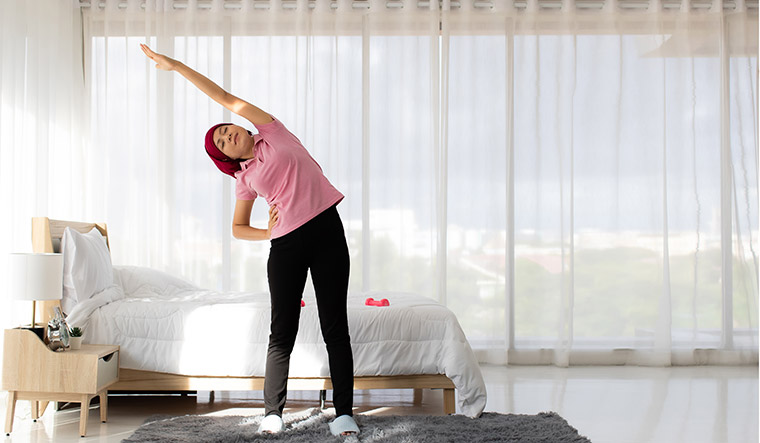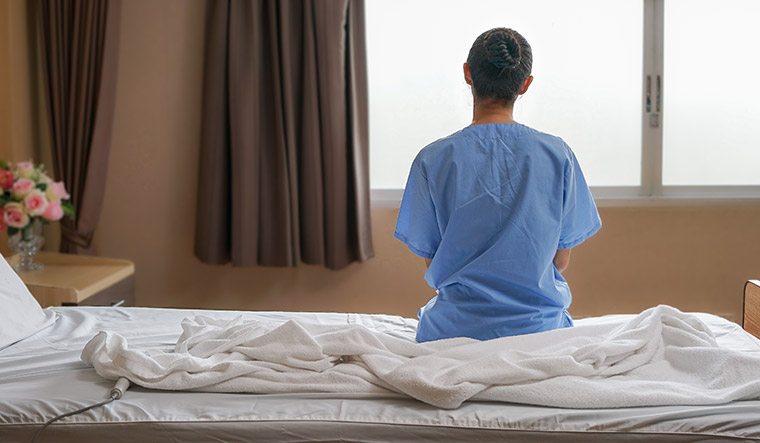In the first head-to-head comparison, mindfulness meditation was as effective as a standard medication for treating anxiety disorders.
The findings of a US study published in JAMA Psychiatry included 276 patients, average age 33 years, who were randomly assigned to either mindfulness-based stress reduction (MBSR) or escitalopram, a medication used to treat depression and generalised anxiety disorders.
MBSR included weekly two and a half hour classes for eight weeks, a day-long retreat weekend class during the fifth or sixth week, and 45-minute daily practice at home.
The participants anxiety levels were assessed before enrolment, after completing the intervention at eight weeks, and at 12 and 24 weeks.
Anxiety symptoms were rated on a scale of 1 to 7, with 7 being severe anxiety levels. The average anxiety score was 4.5 at enrolment.
Anxiety symptoms dropped by an average of 1.35 points for the meditation group and 1.43 points for the medication group.
Severity of anxiety symptoms dropped by a significant 30 per cent for both groups.
Another study presented at the American Heart Association annual meeting found that mindfulness training can help people stick to healthy lifestyle choices that would help them manage their high blood pressure.
Participants who followed an eight-week customised mindfulness programme lowered their systolic blood pressure by nearly six points during a six-month follow-up period, which could translate to a 10 per cent lower risk of heart attack and stroke.
Supplements ineffective at lowering cholesterol
Six commonly used dietary supplements that are promoted as heart healthy were found to be ineffective in lowering cholesterol compared with a low-dose statin, according to a US study published in the Journal of the American College of Cardiology.
The purpose of the study was to compare the efficacy of a low-dose statin with a placebo and six dietary supplements in lowering low-density lipoprotein (LDL) cholesterol as well as their effects on other cholesterol levels and markers of inflammation.
One hundred and ninety adults, aged 40 to 75, with no history of cardiovascular disease, were randomly assigned to a low-dose statin medication rosuvastatin (5mg daily), a placebo, or one of six common supplements which included fish oil, cinnamon, garlic, turmeric, plant sterols or red yeast rice, for a month.
People in the statin group had an average 37.9 per cent decrease in bad LDL cholesterol and an average 24 per cent decrease in total cholesterol, whereas none of the supplements had a significant decrease in LDL cholesterol compared to the placebo.
Rosuvastatin also resulted in a 19 per cent decrease in blood triglycerides while supplements made no difference in triglycerides.
There were no significant adverse events with the use of rosuvastatin. But two of the supplements could be potentially harmful: the garlic supplement increased LDL cholesterol and the plant sterols lowered “good” HDL cholesterol levels.
“This study sends an important public health message that dietary supplements commonly taken for ‘cholesterol health’ or ‘heart health’ are unlikely to offer meaningful impact on cholesterol levels. The results also indicate that a low-dose statin offers important beneficial effects on one’s cholesterol profile,” the study author added.
Exercise on an empty stomach to burn more fat
People who exercised on an empty stomach burned about 70 per cent more fat than those who exercised two hours after eating, suggests a British study published in the International Journal of Sport Nutrition and Exercise Metabolism.
More people prefer to exercise in the evening even though studies have shown that exercising in the morning after an overnight fast yields more benefits than doing the same exercise after a meal.
The researchers wanted to find out if fasted evening exercise would yield similar benefits.
Sixteen healthy men and women performed a 30-minute cycling exercise at moderate intensity at 6.30pm and a performance test which involved cycling as far as they could in 15 minutes.
They did this on two separate days: once after a seven-hour fast (had lunch at 11:30) and once two hours after eating a meal.
The researchers also accounted for how much food they ate at dinner, after exercising.
People who exercised after fasting burned more fat much like those who exercise after an overnight fast. The amount of fat burned increased by about 70 per cent—from 4.5 grams to 7.7 grams.
While those in the fasted group consumed about 100 kcal more calories at dinner, they consumed on average 440 kcal less calories over the course of the day.
But fasting seemed to reduce exercise performance, readiness, pre-exercise motivation and enjoyment, which may make it difficult for some people to stick with it long term.
“Combining exercise and fasting can be a potent way to increase the benefits of exercise,” the study author said.
Did You Know?
Moms to be who drink just one cup of coffee or consume any caffeine products including chocolate, tea, energy drinks and soda may have shorter kids compared to children of women who consumed no caffeine during pregnancy
AMA Network Open
Hair straightening products linked to uterine cancer
Women who use chemical hair straightening products frequently are at an increased risk of uterine cancer compared to women who never use these products, according to a study published in the Journal of the National Cancer Institute.
The study included 33,947 women, aged 35-74, who were followed for almost 11 years during which 378 women were diagnosed with uterine cancer.
Women who frequently used hair straightening products, defined as more than four times a year, were 2.5 times more likely to develop uterine cancer, compared to those who did not use the products.
While the risk of developing uterine cancer by age 70 was 1.64 per cent for women who never used hair straighteners, for frequent users, that risk was more than doubled at 4.05 per cent.
The use of other hair products, including hair dyes, bleach, highlights, or perms, were not associated with an increased risk.
Previous studies have shown that hair straighteners can increase the risk of hormone-sensitive cancers, including breast and ovarian cancer.
Chemical exposure from straighteners could be more concerning than other personal care products due to increased absorption through the scalp which may be exacerbated by burns and lesions caused by straighteners, the researchers noted.
Uterine cancer is the most common cancer of the female reproductive system.
Shorter sleep in later years linked to multiple diseases
Adults over 50, who sleep five hours or less per night, have an increased risk of developing multiple chronic diseases compared to those who sleep seven hours.
The study published in the journal PLOS Medicine included 7,864 men and women who were 50 years old and disease free when the study started in 1985.
The researchers analysed the impact of sleep duration on mortality and the risk of being diagnosed with two or more of 13 chronic diseases (multimorbidity) such as heart disease, stroke, cancer, dementia, diabetes, heart failure, chronic obstructive pulmonary disease, kidney disease, liver disease, depression, mental disorders, Parkinson’s and arthritis.
Over 25 years of follow up, 4,446 participants developed their first chronic disease, 2,297 progressed to multimorbidity, and 787 subsequently died.
Those who slept five hours or less at age 50 had a 30 per cent greater risk of multimorbidity compared with those who slept for seven hours. At age 60, shorter sleepers had a 32 per cent greater risk and at 70, a 40 per cent greater risk.
Sleeping longer than nine hours at age 60 and 70 was also associated with an increased risk of chronic diseases, but the diseases could be the reason for the longer sleep times.
The study highlights the importance of optimal sleep duration for good health in midlife and old age.
Intermittent fasting leads to eating disorders?
According to a Canadian study published in the journal Eating Behaviors, though intermittent fasting is a popular dietary trend that promotes weight loss, it may not be as safe as generally thought.
Intermittent fasting may lead to dangerous eating disorder behaviours among adolescents and young adults.
The researchers analysed data from 2,762 adolescents and young adults from the Canadian Study of Adolescent Health Behaviours.
Intermittent fasting was associated with all disordered eating behaviours for women, including binge-eating, as well as compensatory behaviours like vomiting and compulsive exercise. Men who did intermittent fasting were more likely to engage in compulsive exercise.
Intermittent fasting was very popular among study participants: 47 per cent of women, 38 per cent of men, and 52 per cent transgender or gender non-conforming individuals engaged in intermittent fasting an average of 100 days over the previous 12 months.
“We need more education in healthcare settings and greater awareness in popular culture, including social media, of the potential harms of intermittent fasting,” the study author warned.
Did You Know?
Children born to parents who are younger than 20, or those born to mothers older than 35 and fathers older than 45 are at increased risk of being diagnosed with bipolar disorder later in life
European Neuropsychopharmacology
Exercising during chemo helps with recovery
Exercising during chemotherapy can improve cardiorespiratory fitness in cancer patients and help them recover faster from the gruelling effects of the treatment.
During cancer treatment, peak oxygen uptake, an indicator of cardiorespiratory fitness, declines by up to 25 per cent. Cancer treatment can also cause extreme fatigue and cardiovascular morbidity and impair the quality of life.
The Dutch study published in the journal JACC: CardioOncology included 266 patients undergoing chemotherapy for testicular, breast, or colon cancer or non-Hodgkin's lymphoma.
The participants were randomly assigned to a six-month exercise programme either during their chemo treatment, or after treatment.
Exercise included 30 minutes of cardio on a stationary bike or treadmill 3 days a week, 20 to 30 minutes of weight training twice a week, and a recreational sport like indoor hockey, soccer, or badminton once a week.
After chemotherapy was completed, those who exercised during the treatment had significantly lower decreases in peak oxygen uptake and muscle strength and reported less fatigue and more physical activity, which hastened their return to normal life, compared to those who exercised after treatment.
Those who began exercising after chemotherapy also showed some improvement. In fact, participants in both groups returned to their baseline cardiorespiratory fitness one year after completing the exercise regimen.
“These findings suggest that the optimal timing of physical exercise is during chemotherapy. However, initiating a physical exercise programme after chemotherapy is a viable alternative when exercising during chemotherapy is not possible,” the study concluded.
Did You Know?
Following a low-carbohydrate diet helped participants whose blood sugar ranged from prediabetic to diabetic levels and who were not on diabetes medication to significantly lower their hemoglobin A1c by 0.23 per cent compared to those following their regular diet
JAMA Network Open
Hospital room may impact recovery
Certain hospital room features such as the number of patients per room and the distance from a nurse’s station may impact recovery outcomes after undergoing high-risk surgeries, according to a US study presented at the Scientific Forum of the American College of Surgeons Clinical Congress.
The study included 3,964 patients who underwent one of 13 high-risk surgical procedures, including colectomy, pancreatectomy, and kidney transplant.
Patient rooms were coded based on their features, such as window or no window, single occupancy or double occupancy, distance to the nursing station, and line of sight to clinicians.
Health records were used to analyse clinical outcomes, including mortality and length of stay, related to room design.
Patients had better recovery and higher survival rates if they had a single occupancy room; their room was closest to a nursing station on their floor; and in a location with a clear line of sight where providers could see into the room.
Compared to those who were admitted to rooms that had all the above features, people in rooms that had none of these features were 50 per cent more likely to die post-surgery.
A double room occupancy increased mortality risk by 35 per cent, while patients in rooms farther from a nursing station had nearly 36 per cent increased risk of death.
Mortality rates were 20 per cent higher if patients were admitted to a hospital room without a window than if they were in a room with a window.








